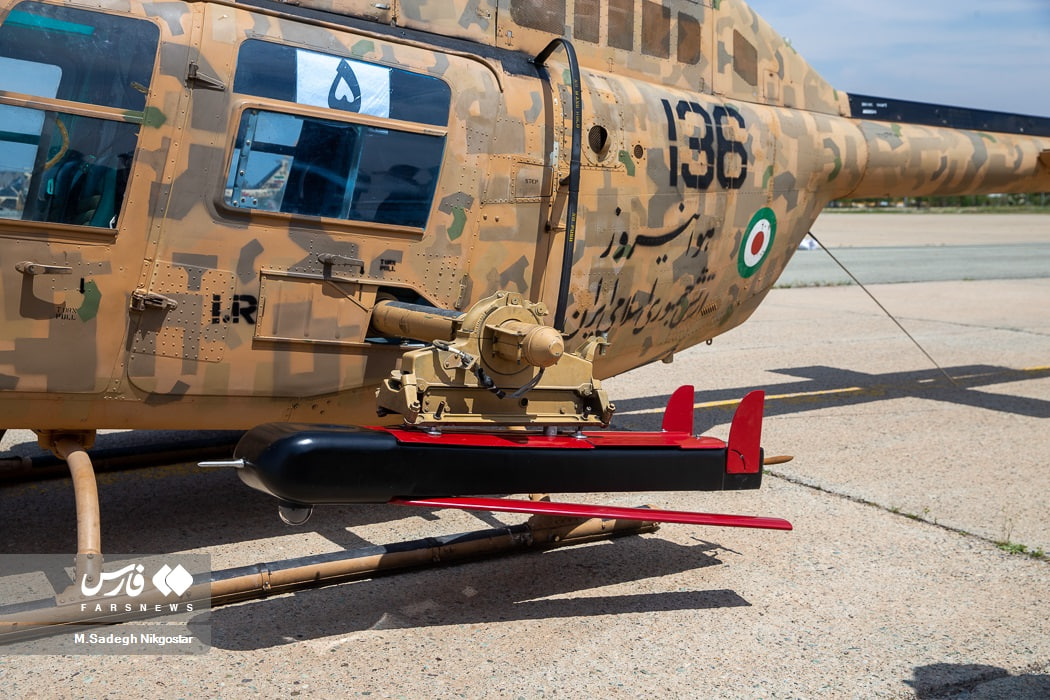News footage from Iranian state media has revealed a new air-launched reconnaissance and loitering munition on its Bell 206 helicopter during a military parade rehearsal.
The unnamed drone is one in a series of several such Unmanned Aerial Vehicles (UAV) that Iran has unveiled over the last few months, especially since tensions with neighboring Israel and the United States have gotten worse.
The most recent introduction has been the Meraj-532 kamikaze drone launched from a car, as shown in a video. The country’s drone prowess rose to prominence when Russia widely used its Geranium-2 (Geran-2) suicide drones on Ukrainian targets since late last year to devastating effect.
The loitering munition was, later concluded by a few reports, to have been derived from the Iranian Shahed-136 drone.
Reconnaissance-Cum-Kamikaze Drone?
The latest drone was seen in the semi-official Fars news agency footage, showing a massive parade of several Bell AH-1J Cobra attack helicopters and Bell 206 light utility helicopters. The helicopters were practicing during the Army Aviation Day aerial flypasts.

The American-made AH-1J, Bell 206, Bell 214, UH-1H Huey, F-5 Tiger, F-14 Tomcat, and the F-4E Phantom II were acquired during the monarch Reza Shah Pahlavi’s reign in the 1970s, before 1979 Islamic Revolution deposed him.
Since then, sanctions from the United States have blocked Iran’s access to spare parts, forcing a long-running concerted techno-industrial effort to reverse engineer and build some of the aerospace components within the country. The pursuit has not, however, been entirely successful, and Iran has to use many of its airframes sparingly, affecting training and safety records.
The drone has a swiveling electro-optical system, indicating that light tactical reconnaissance has to be an intended role.
While its specifications have not been published, considering the placement of its electric motor, retractable wings, and overall rectangular cube shape, it would be unlikely that it is not a loitering munition. And with Iran’s strategy of using cheap yet capable drones in swarms, it can be safely assumed that dozens of such drones can also be launched from multiple tubes in boxes.
Moreover, the Bell 206 primarily has a reconnaissance and surveillance role. Thus, equipping it with such a drone gives it immense tactical versatility. The chopper can stay further away from a hostile area or battle zone and launch the UAV in the direction it intends to conduct surveillance.
This increases the surveillance range of the helicopter by possibly several dozen kilometers. Moreover, if the drone has a capable warhead and a proven one-way suicide mission capability, it can take some load off frontline attack helicopters, infantry, and armor in hitting enemy ground targets.
Suitable tactics in piloting both the helicopter and the drone and sharing the data with tactical command and control can achieve significant battlefield advantages. While there is no official word on the drone’s actual role, inferences can be drawn based on Iran’s known techno-military strategy and doctrine that has become public over the last few years.
May Guide Haider Cruise Missile Too
It is possible that data gathered by the drone can also be shared for larger missile strikes, like the Haider cruise missile. One picture from March this year showed one missile each attached to both the external weapons bays of a Bell 214 helicopter.
At a Army Aviation (Havanirooz) exhibition, the Heidar cruise missile was shown off:
• Weighs 60kg (warhead is 25kg)
• Length of 370cm
• 500km/h speed
• 200km range
• CCD/IIR seeker in the nose
• Used by both MALE UCAVs such as Fotros or Bell-214 helicopters like seen here pic.twitter.com/faUfbCayj4— Iran Defense|نیروهای مسلح جمهوری اسلامی ایران (@IranDefense) March 12, 2023
The photos from the parade showed various helicopters flying in large formations, hinting about tactical pairs of aircraft that Iran is likely to employ. The US used the OH-58 Kiowa Warrior as a surveillance, scout, target acquisition, and fire support platform for aerial and ground assets.
Iran doesn’t have advanced long-range surveillance aircraft, strategic ISR drones like the RQ-4B Global Hawk, or a satellite constellation to provide targeting data to its ground attack cruise missiles or surface-to-surface ballistic missiles.
Thus, unnamed drones like those in the picture must have dual tactical reconnaissance and attack roles.
- The author can be reached at satamp@gmail.com
- Follow EurAsian Times on Google News




